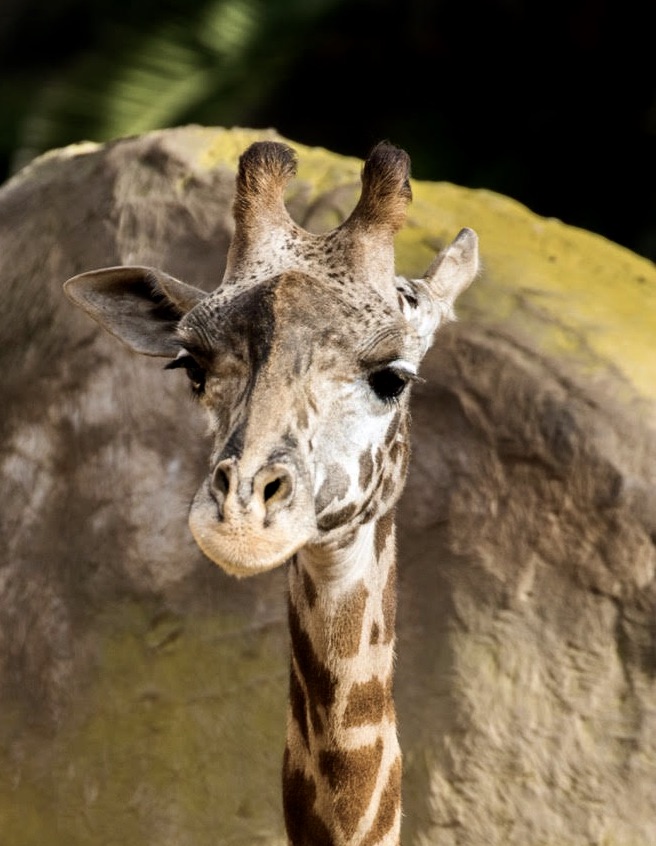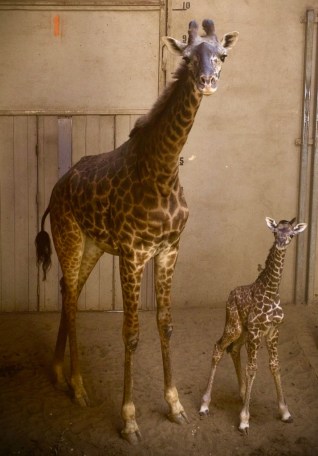Santa Barbara Zoo Staff Mourns Death of Newborn Giraffe
Calf Showed Signs of Distress Soon After Birth

On Wednesday, July 22, Audrey the giraffe’s wee calf died less than 24 hours after being born.
Audrey, a 12-year-old Masai giraffe, went into labor about 6 p.m. on Tuesday. Just under two hours later, her female calf arrived. Soon after, however, it was clear there were complications, as the calf was struggling to get up on her feet despite help and encouragement from Audrey. Healthy newborn giraffes are generally standing on their wobbly legs within the first hour of birth.
The assembled giraffe keepers and Dr. Julie Barnes, the zoo’s vice president of animal care and health, intervened on the calf’s behalf. The team massaged her legs, shoulders, and hips, warmed her with dry towels, and leaned her against a hay bale to use for leverage when she tried to stand, among other mediations. The staff provided dedicated care throughout the night, but by the next morning, the baby’s condition had not improved.
Get the top stories in your inbox by signing up for our daily newsletter, Indy Today.
“Immediately following the delivery, the calf was not showing normal behavior, appeared weak and was unable to stand on its own,” said Dr. Barnes. “The calf exhibited several potential congenital abnormalities that the animal care team suspects contributed to the calf’s lack of responsiveness and inability to get up. Our devoted animal care team cared for the calf and her mother, Audrey, around the clock after the birth, and despite tremendous efforts, there was no improvement in the calf’s condition. Taking into consideration the calf’s very poor prognosis for survival, we made the decision to euthanize her. We share this news with a very heavy heart.”
While the determinant factors of the calf’s underlying health issues aren’t yet known — “it is also possible that the calf may have experienced some sort of fetal distress in-utero or during birth,” explained Dr. Barnes — a necropsy (animal autopsy) will be performed at the UC Davis California Animal Health and Food Safety Laboratory in San Bernardino. A pathology report will be received in several weeks.

Over the years, there have been many successful giraffe births, such as Twiga, who was born in March 2020. Audrey, who is back with the herd and doing well, has had four healthy babies to date. The truth is that pregnancy and giving birth come with inherent risks whether the animal is in the wild or in human care.
Despite the heartbreaking death of Audrey’s calf, the zoo will continue its part in the conservation of the Masai giraffe. Michael, the 13-year-old male who has sired all the calves born at the zoo, is the most genetically important Masai in the U.S. — he has no other relatives beside his offspring which makes him genetically desirable.
Michael was four years old when he came to Santa Barbara in 2011. Since then, he has sired eight calves, including Twiga. His seven other offspring have been moved to other accredited zoos as part of a collaborative Species Survival Plan to ensure that genetic diversity is maintained, which allows the population to flourish. The SSP was created in 1981 by the Association of Zoos and Aquariums to ensure the survival of threatened and endangered animals.
Masai giraffes are currently considered endangered by the International Union for Conservation of Nature, as there are only about 37,000 Masai in their natural habitats in Kenya and Tanzania. That is a 50 percent decline in population over the past 30 years. Africa’s overall giraffe population has been reduced by 40 percent in the same amount of time due to habitat loss and poaching. Of the nine giraffe subspecies, the Masai is the largest, growing as tall at 17 feet and weighing more than a ton.
“The loss of any animal is heartbreaking for our entire zoo family, and we are grieving this loss,” shared Rich Block, Santa Barbara Zoo’s president & CEO. “Despite the unfortunate outcome, I’m proud of the zoo team for the great measures they took to try to save Audrey’s calf. We are grateful for the support of our community, as well as from our professional conservation community, as we continue our commitment to working to protect the future of wildlife.”
Every day, the staff of the Santa Barbara Independent works hard to sort out truth from rumor and keep you informed of what’s happening across the entire Santa Barbara community. Now there’s a way to directly enable these efforts. Support the Independent by making a direct contribution or with a subscription to Indy+.




You must be logged in to post a comment.